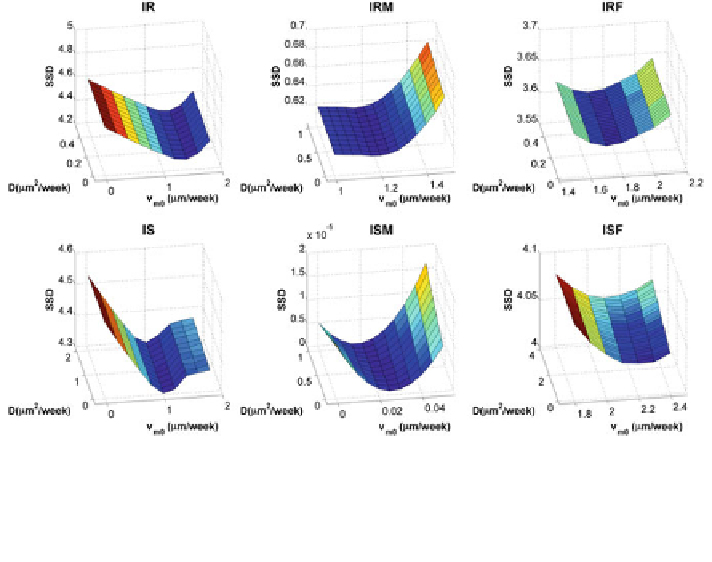Biomedical Engineering Reference
In-Depth Information
Fig. 8 Lipolysis/lipogenesis have the greater effect on the cost function than lipid turnover:
The cost function (sum of square differences (SSD) between adipocyte dynamics and non-
transient body composition changes) as a function of lipid turnover (diffusion, D) and lipogenesis/
lipolysis (convective velocity, v
m0
). Groups shown: Insulin Sensitive (IS) and Insulin Resistant
(IR), Males (M) and Females (F) at 0 % of total energy from carbohydrates
entire distribution in one direction. As such, it should follow that a larger value for
the convective parameter should lead to faster weight gain than a smaller convective
velocity. In contrast, lipid turnover is negligible (D\10
4
lm
2
/week) in males but
not in females. This suggests that lipid is being added to the adipocytes and thus there
is very little turnover. This is consistent with the evidence that lipid turnover is
higher in women than in men, possibly related to catecholamines [
39
,
40
].
Observing a consistent trend in IRM and ISM in terms of lipid turnover, and
lipogenesis and lipolysis under weight gain and weight loss respectively, cost
surfaces were computed for both IRM and ISM at a finer resolution using step
increases of 10 % in carbohydrate fraction of dietary intake. Weight gain conditions
presented differently shaped cost surfaces but weight loss conditions presented
almost identical trends (Figs.
9
and
10
). At a rate of 10
3
lm
2
/week, lipid turnover
is very small compared to the rate of lipogenesis. This is in contrast to the non-
negligible lipid turnover found in the IRF and ISF groups. The minima provide
insight into the previously mentioned transient rise and fall in lipid turnover during
weight loss. Both IRM and ISM show a peak lipid turnover that then decreases as
the carbohydrate percentage in the diet increases. However, the diet at which
turnover is maximized is different as IRM peaks at 80 % while ISM peaks at 90 %.
Both exhibit a sigmoidal increase in rate of lipolysis from 50 to 100 % of diet from
carbohydrates. Under weight gain conditions, ISM exhibits a rapid decrease in the
rate of lipogenesis as the carbohydrate percentage increases from 0 to 50 %.

Search WWH ::

Custom Search